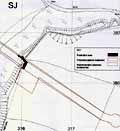| |
|

Sketch plan
of earthwork feature and trenches

View from site towards the west

North-west facing section through ditch |
|
|
|
Wat's Dyke is less well known than Offa's Dyke which runs
parallel to it further west, but is nevertheless an
important boundary and a major feature of the
archaeological landscape of the Welsh Marches. It is not
known exactly when the Dyke was constructed, but recent
radiocarbon dating evidence has suggested that it was
probably built between A.D. 268 and A.D. 630. This has
overturned the previously held belief that it was
constructed in the 8th century.
Despite many investigations into the course of Wat's Dyke
over the last thirty years, the route of the section east
of Chirk remained unclear. In the 18th century Thomas
Pennant suggested that the route follwed a straight line
crossing the river Ceiriog and the river Dee. In the
middle of the 20th century Sir Cyril Fox suggested that
in forested and marshy areas the dyke was not built. More
recently David Hill and Margaret Worthington have tested
this and shown the dyke seems to have been continuous. An
alternative route for this section of Wat's Dyke was
along the top edge of the valley through which the
Ceiriog and the Dee flow.
Prior to laying a new gas pipeline between Overton and
Chirk a desk based assessment for Transco identified an
earthwork at the top of a steep hill which may have been
the course of Wat's Dyke.
A small scale evaluation excavation across the earthwork
confirmed that there was a 2.1m wide ditch starting 4
metres below the top of the slope. To the east of the
ditch were the remains of a bank, increasing the severity
of the slope. Micromorphology was carried out on a soil
sample which confirmed that there was a buried soil below
the bank. The evaluation trench was extended behind the
bank but no contemporary features were found.
There is no clear reason for a ditch and bank existing in
isolation and as its form is consistent with other
excavated parts of the dyke, there seems little doubt
that this very small investigation has defined the long
debated course of the Dyke in this area.
Transco have now laid the new pipeline, with no further
disturbance to this important monument.
|



